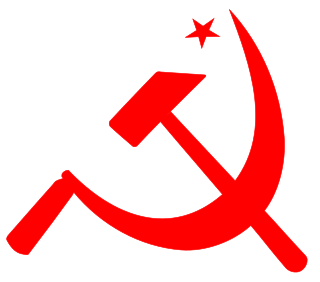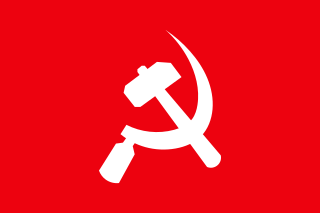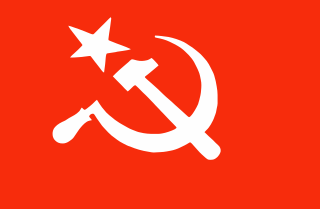
The Communist Party of India (Marxist) (abbreviated as CPI(M)/CPIM/CPM) is a communist political party in India. It is the largest communist party in India in terms of membership and electoral seats, and one of the national parties of India. The party was founded through a splitting from CPI in 1964 and it quickly became the dominant fraction.

The Communist Party of India (Marxist–Leninist) (CPI (ML)) was an Indian communist party formed by the All India Coordination Committee of Communist Revolutionaries (AICCCR) at a congress in Calcutta in 1969. The foundation of the party was declared by Kanu Sanyal at a mass meeting in Calcutta on 22 April, Vladimir Lenin's birthday. Later the CPI(ML) party splintered into several Naxalite groups.

Communist Party of India (Marxist-Leninist) is a anti-revisionist Marxist–Leninist communist party in India. After the death of Charu Majumdar in 1972 the Communist Party of India (Marxist-Leninist) pro Charu Majumdar central committee was led by Mahadev Mukherjee and Jagjit Singh Sohal, and the Central Committee took a stand to defend the line of Charu Majumdar on 5–6 December 1972.

The Provisional Central Committee, Communist Party of India (Marxist–Leninist) is a communist political party in India. The general secretary of the party was Santosh Rana. The party is often referred to as CPI(ML) [Santosh Rana Group] or likewise.
Andhra Pradesh Coordination Committee of Communist Revolutionaries (APCCCR) was a leftist split from the Communist Party of India (Marxist) in the Indian state of Andhra Pradesh. The leader of the group was T. Nagi Reddy, who was a member of the legislative assembly in AP at the time. Other leading figures were D.V. Rao, Chandra Pulla Reddy and Kolla Venkaiah. Both Reddy and Rao had been active in the Telangana armed struggle, and Rao had formulated the "Andhra Thesis" of the Communist Party of India (CPI).
Communist Revolutionary League of India (CRLI) is a political party in the Indian state of West Bengal. The party is led by Ashim Chatterjee, former student leader of Communist Party of India (Marxist-Leninist). Chattejee broke with Charu Majumdar in 1971 after the failure of the attempts to build an armed movement in the Debra-Gopiballavbur area in West Bengal and due to the opposition of CPI (ML) towards the liberation struggle of Bangladesh. Chatterjee formed the Bengal-Bihar-Orissa Border Regional Committee, CPI (ML). His group joined the CPI (ML) of Satayanarayan Singh. Later Chatterjee formed the CRLI.

Tarimela Nagi Reddy was a communist politician from Andhra Pradesh, India. He was born in a wealthy family in Anantapur district of Andhra Pradesh. He completed his schooling from the Rishi Valley School India, founded by Andhra philosopher Jiddu Krishnamurti. He would later study at Loyola College in Chennai and at Banaras Hindu University in Varanasi. During his student days, he got involved with nationalism and Marxism. His political activities got him jailed in 1940, 1941 and 1946. He revolted against his father who was a landlord and donated his land of over 1000 acres to landless labourers.
Communist Party of India (Marxist-Leninist) Second Central Committee or CPI (M-L) 2nd CC is a political party in India. It emerged in 1973 when the pro-Charu Majumdar faction of the original CPI (M-L) got divided into pro and anti-Lin Piao groups. The CPI (M-L) 2nd CC represents the pro-Lin Piao stream. At present, the party is active in states like Bihar, Uttar Pradesh and West Bengal.

The Socialist Unity Centre of India (Communist) or SUCI(C), previously called the Socialist Unity Centre of India and "Socialist Unity Centre", is an anti-revisionist Marxist-Leninist communist party in India. The party was founded by Shibdas Ghosh, Nihar Mukherjee and others in 1948.
Mamidi Appalasuri was an Indian communist leader. Appalasuri was one of the leaders of the tribal uprising in Srikakulam. When the Andhra Pradesh Committee of Communist Revolutionaries was expelled from the All India Coordination Committee of Communist Revolutionaries in 1968, Appalasuri remained with the AICCCR led by Charu Majumdar. In 1969 Appalasuri was one of four Central Committee members of the new Communist Party of India (Marxist-Leninist) from Andhra Pradesh.
Communism in India has existed as a social or political ideology as well as a political movement since at least as early as the 1920s. In its early years, communist ideology was harshly suppressed through legal prohibitions and criminal prosecutions. Eventually, communist parties became ensconced in national party politics, sprouting several political offshoots.
Vempatapu Satyanarayana (Satyam) was a schoolteacher, member of several Indian Communist organizations, and a leader of the Srikakulam peasant uprising of 1967, along with Adibhatla Kailasam and Subbarao Panigrahi. They had started the "land to tiller" movement in Andhra Pradesh, which later spread to South Odisha.

The Naxalite–Maoist insurgency is an ongoing conflict between Maoist groups known as Naxalites or Naxals and the Indian government. The influence zone of the Naxalites is called the red corridor, which has been steadily declining in terms of geographical coverage and number of violent incidents, and in 2021 it was confined to the 25 "most affected" locations, accounting for 85% of Left Wing Extremism (LWE) violence, and 70 "total affected" districts across 10 states in two coal-rich, remote, forested hilly clusters in and around the Dandakaranya-Chhattisgarh-Odisha region and the tri-junction area of Jharkhand-Bihar and-West Bengal. The Naxalites have frequently targeted police and government workers in what they say is a fight for improved land rights and more jobs for neglected agricultural labourers and the poor.
Communist Party of India (Marxist–Leninist) People's War, usually called People's War Group (PWG), was an underground communist party in India. It merged with the Maoist Communist Centre of India to form the Communist Party of India (Maoist) in 2004. Muppala Lakshmana Rao ('Ganapathi') was the general secretary of the party. The ideology of the party was Marxism-Leninism-Maoism.
Satyanarayan Singh was an Indian communist politician. Singh was one of the early leaders of the Communist Party of India (Marxist-Leninist), being its secretary in Bihar.
Sushital Ray Chowdhary was an Indian Communist intellectual and founder member of Communist Party of India (Marxist-Leninist). He was the editor of the organs of the CPI, CPI(M) and CPI(ML). He eventually fell out with the mainstream Charu Majumdar group and died of a heart attack in March, 1971.

Naxalbari uprising was an armed peasant revolt in 1967 in the Naxalbari block of Siliguri subdivision in Darjeeling district, West Bengal, India. It was mainly led by tribals and the radical communist leaders of Bengal and further developed into the Communist Party of India (Marxist–Leninist) in 1969. The armed struggle became an inspiration to the Naxalite movement which rapidly spread from West Bengal to other states of India creating division within the CPI(M) - India's primary communist party.
Central Organising Committee, Communist Party of India (Marxist–Leninist) was a communist party in India, one of the main splinter factions of the original Communist Party of India (Marxist–Leninist). COC, CPI(ML) occupied a middle position between the pro-Charu Majumdar group led by Mahadev Mukherjee and the anti-Majumdar group led by Satyanarayan Singh. Failing to articulate a common ideological position, COC, CPI(ML) soon suffered internal divisions and splits. Two of the splinter groups of COC, CPI(ML) in Andhra Pradesh are predecessors of the present-day Communist Party of India (Maoist).

In 1964, a major split occurred in the Communist Party of India. The split was the culmination of decades of tensions and factional infighting. When India became independent in 1947, differences arose of how to adapt to the new situation. As relations between the Nehru government and the Soviet Union improved, a faction that sought cooperation with the dominant Indian National Congress emerged within CPI. This tendency was led by S.A. Dange, whose role in the party hierarchy became increasingly controversial. When the Sino-Indian War broke out in 1962 Dange's opponents within CPI were jailed, but when they were released they sought to challenge his leadership. In 1964 the party was finally divided into two, with the left faction forming the Communist Party of India (Marxist). The split had a lot of regional variations. It also impacted other organizations, such as trade union and peasant movements. The split has been studied extensively by scholars, who have sought to analyze the various domestic and international factors involved.






